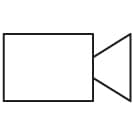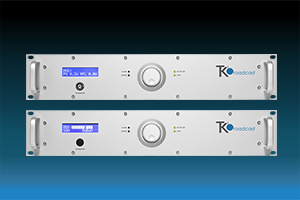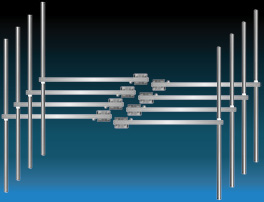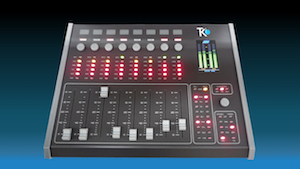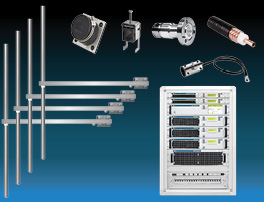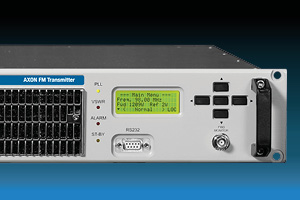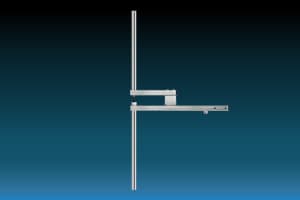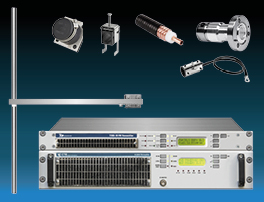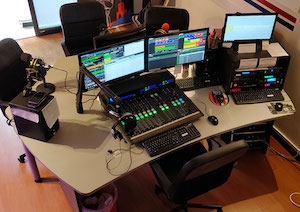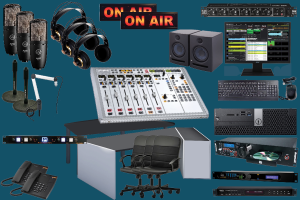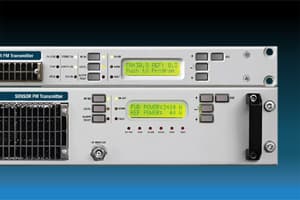How much distance does a radio transmitter cover?
COVERAGE IN KILOMETERS OF AN FM TRANSMITTER AND ITS ANTENNA SYSTEM
This guide aims at predicting how many kilometers can be covered by an FM Transmitter associated with its antenna system.
This post will cover a few key points:
- Common questions from our customers
- The ERP (effective radiated power) formula
- How to choose the right connector and cable for your transmitter and antenna
- Attenuation of the Coaxial Cable
- The distance covered at different heights of the antenna system
Common questions from our customers:
- How to decide how much power I need for an FM transmitter?
- What is the best antenna system and cable to use?
- How much Power does a radio station need to cover a determinate area?
- I need an FM Transmitter to cover 90 kilometers.
- Please quote me a complete radio station to cover 150 kilometers.
- Please quote me a complete radio station for a community radio.
- We're in the process of starting a community broadcast and would
like to know how much to budget for such a venture!
These are some common requests that we receive from our customers. They need professional advice from industry experts to decide which
option is best for them.
With the following guide we will try to help them answer these questions.
The most difficult decision concerns the power range of the FM Transmitter and the type of Antenna System to be used.
Most of the time the doubts are not related to Radio Studios.
In these cases it is easier, without being a specialist in the sector,
to orient oneself towards which type of equipment to buy, and most of the
time the choice depends exclusively on the available budget.
The most difficult thing is deciding the right
power of the FM Transmitter and the type of Antenna to be used.
What follows is a simplified guide with some advice, and data; it is not an exhaustive guide, but rather a useful list of the factors that will determine the coverage or the distance, in kilometers, that can be potentially reached by the FM signal.
Factors that determine the coverage of an FM Transmission system.
The analysis below is based on mathematical calculations, which – in summary – demonstrate that the coverage of a transmitting system depends on the power of the transmitter, the antenna system, the height at which the antennas are mounted and the type of area to be covered.
The best advice TEKO Broadcast can give you is to build the system with a good transmitter but not to overlook the type of antenna and the height of the installation point.
With regard to the power of the transmitter, in order to make a proper prediction of the
potential distance that can be reached, there is a memo-technical rule that may
be applied: if we double the distance covered, we need to
quadruple the power of the transmission system.
In other words: distance by two, power by four.
There are many factors that determine how far the FM signal radiated by the transmitter/antenna system will reach.
A good estimate can be attained by considering four of these factors:
- The effective radiated power (ERP)
- The antenna height
- The shape of the terrain
- The area to be covered: rural, urban or large town.
The first parameter we need to take into account is the ERP, which is the effective
radiated power of the total transmitting system.
To calculate the ERP, you need to know the following factors:
- The output power of the transmitter
- The losses of the coaxial cable used to connect the transmitter to the antenna.
- The length of the coaxial cable.
- The type of antenna system: dipole vertical polarization, circular polarization, single antenna, systems with 2 or more antennas, etc.
- The gain of the antenna system in dBb. The gain can be positive or negative.
The ERP formula is:
ERP = Transmitter power in Watt x 10^((Gain of the antenna system in dBb - losses of the cable) / 10)
Example:
Power of the FM Transmitter = 1000 Watt
Type of antenna = 4 bay dipole vertical polarization with a gain of 8
dBb
Type of cable = low losses 1/2”
Length of cable = 30 meters
Attenuation of the cable = 0,69dB
ERP = 1000W x 10^(8dB - 0,69dB)/10 = 3715W
Thus, the system described in the formula would effectively provide approximately
3 times the transmitter power, to an ERP of 3715 Watts, with a 152 kilometers
coverage.
It must be noted, however, that this is only a theoretical calculation: in order to reach inside houses and pass through obstacles much more power is needed to cover the same distance.
How to choose the right connector and cable for your transmitter and antenna.
| Alluminium Dipole Antenna | |||
| BAYS | POWER UP TO | CONNECTOR | CABLE |
|---|---|---|---|
| 1 | 800W | N | RG213 |
| 2 | 1600W | 7/16'' | 1/2'' |
| 4 | 3200W | 7/8'' | 7/8'' |
| Stainless Steel Dipole Antenna with Connector 7/16'' | |||
| BAYS | POWER UP TO | CONNECTOR | CABLE |
| 1 | 2000W | 7/16'' | 1/2'' |
| 2 | 4000W | 7/8'' | 7/8'' |
| 4 | 8000W | 7/8'' | 7/8'' |
Attenuation of the Coaxial Cable.
What follows is a table that describes the typical attenuation and
the maximum allowed power of the different Coax Cables typically used:
| Attenuation at 100MHz | Attenuation db/100m | Attenuation db/30m | Maximum Averange Power Rating |
|---|---|---|---|
| RG213 | 6,2 | 1,86 | 1000 |
| RG214 | 7,5 | 2,25 | 800 |
| RG218 | 3 | 0,9 | 3500 |
| CLX 1/4" (Foam) | 4,5 | 1,35 | 1500 |
| CLX 1/2 (Foam) | 2,3 | 0,69 | 3400 |
| CLX 7/8 (Foam) | 1,2 | 0,36 | 7500 |
| CLX 1 5/8 (Foam) | 0,7 | 0,21 | 15000 |
The total power radiated is necessary to win the attenuation of the
air on free space, called: “Free space attenuation in dB”.
The attenuation of the air on free space is 72,4dB x 1 kilometer.
This attenuation increases by 6 dB each time the distance is doubled, so,
for 2km it is 78,4dB, 84,4dB for 4km, and so on...
This means we loose 4 times the power each time the distance
is doubled.
Table of Free-space attenuation at 100MHz:
| Free-space attenuation (dB) at 100MHz | |
|---|---|
| Distance (Km) | Attenuation (dB) |
| 1 | 72,4 |
| 2 | 78,4 |
| 3 | 81,9 |
| 4 | 84,4 |
| 5 | 86,6 |
| 6 | 88 |
| 7 | 89,3 |
| 8 | 90,5 |
| 9 | 91,5 |
| 10 | 92,4 |
| 15 | 95,9 |
| 20 | 98,4 |
| 25 | 100,4 |
| 30 | 101,9 |
| 35 | 103,3 |
| 40 | 103,4 |
| 50 | 106,4 |
| 100 | 112,8 |
Once we know the ERP there are many other factors to be considered:
- The height of the antenna above the area to be covered. A way to understand it is to imagine how far the transmitting antenna can effectively see. If you stand in the same point the antenna is mounted and look out with a pair of binoculars, wherever you can see it is possible to transmit to. This can be 5 or 6 kilometers if you are standing on a flat terrain, or up to 30 or 40 kilometer if you are on a mountain top.
- The height of the trees in the area around the antenna.
- The height of the buildings around the antenna.
- The type of terrain, flat or hills.
- The sensitivity of the receiver.
- The proximity of other radio stations broadcasting in the same frequency. For example, the antenna may be able to see 20 kilometer away, but if another station is on the same frequency 20 kilometers away, it will block/interfere with the signal.
In general one of the most important aspects is the topography of the
terrain: hills, mountains, large buildings of the city, windows or walls through which to pass in order to get inside the houses....
The C.C.I.R. says the minimum level of signal needed to have a good reception in the different areas is as follows:
Rural areas = 48 dBμV
Urban areas = 60 dBμV
Large towns = 70 dBμV
The following table illustrates the approximate coverage in Kilometers of a rural area with different values of ERP:
| Watts in ERP | Kilometers Rural area |
|---|---|
| 10 | 8 |
| 30 | 13 |
| 50 | 17 |
| 100 | 24 |
| 300 | 42 |
| 500 | 54 |
| 1000 | 76 |
| 2000 | 108 |
| 4000 | 152 |
| 6000 | 187 |
| 10000 | 241 |
The following table illustrates, taking account of the terrestrial curve, the distance covered with different heights of the antenna system:
| Height (meters) | Distance (km) |
|---|---|
| 3 | 6 |
| 10 | 11 |
| 20 | 16 |
| 30 | 20 |
| 60 | 28 |
| 100 | 36 |
| 300 | 62 |
| 500 | 80 |
| 1000 | 113 |
| 2000 | 160 |
| 3000 | 196 |
The FM signal will propagate as far as there is optical visibility.
If you look at the horizon with binoculars, the maximum distance we
can look at is called the "Line of sight".
The FM signal does not go beyond this distance.
This is why the height of the antenna is so crucial.
Example of the coverage of the same FM Transmission system installed at different heights:
You could have two different radio stations using a 1000 Watt FM transmitter: one of them with a 30 meter tower in a flat terrain will cover 20 kilometers, while the other with the antenna on a 500 meter hill will cover 80 kilometer.
It must be known that the range can only be estimated and results cannot be guaranteed until after a given system has been tested in real practice.
In conclusion, to know the effective coverage of a transmission system we must consider all these factors, but mainly: the Effective Radiated Power, the Antenna height from the terrain, and the type of area to be covered: Rural, Urban, Towns or Large Towns.
If the antenna can see 20 kilometers away, but an ERP of 10 Watt is used, it is
probable that no more than 8 kilometers will be covered, because there
is not enough power to propagate the signal as far as 20 kilometers.
If an ERP of 100 Watt is used, it is very likely that 20 kilometers of range
will be reached because a 100 Watt ERP is able to propagate a strong
signal as far as 20 kilometers.
If an ERP of 1000 Watt is used, it is very probable that the signal
will reach 20 kilometers, and it will also penetrate
eventual obstacles.
Blog
Recommended products
Recommended product categories
Last Blog News
This is the abstract
Guide to predict how many kilometers can be covered by an FM Transmitter associated with its antenna system
Complete guide about selection of fm broadcast equipment and fm radio station equipment
How an FM transmitter helps covid 19 social distance with Drive-in theatre


